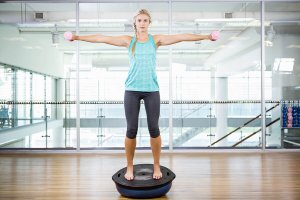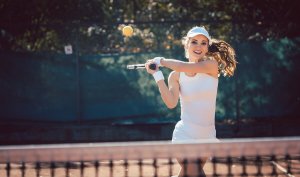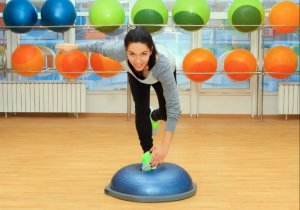Proprioception: What is it and Why is it Important?

The term “proprioception” isn’t very common. However, it’s a very important part of our everyday lives, whether we’re athletes or not. If you’re recovering from a musculoskeletal injury, you might even have specific exercises to work on it.
What is proprioception?
Proprioception is the sense that lets you know what position your body is in at all times. These structures send this information to the brain:
- Capsuloligamentous proprioceptors: these are in the joint capsules and tendons. They tell the brain what position the joints are in.
- Vestibular proprioceptors: they’re located in the inner ear. In fact, they let you know what position your head holds at all times.
- Neuromuscular spindles: located inside the muscles, these let you know when muscles are slightly stretched. Also, they’re important because they protect you from sudden and abrupt stretching. They make the muscle fibers contract to protect themselves.
- Golgi tendon organs: found in the tendons and at the myotendinous junction. Here, the muscles relax when there’s too much tension.
Therefore, proprioception helps you to stay balanced. Also, it helps you prevent injuries when you play sports.

Why you should work on it
Proprioception is something you can train, develop, and improve. It’s good to work on because your body can function better. The more you work on it, the better your balance will be. Then, your body will be able to prevent injuries better.
For example, you could hike in the mountains and step on a stone without realizing it. A sedentary person would probably twist his ankle, and there’s a high chance of spraining it. However, an athlete or someone that works on proprioception will stumble but will react and recover.
In fact, this is because people that don’t exercise don’t always have the required skills to prevent injuries. The rate their body transmits information isn’t fast enough. So, the body can’t fix the ankle’s position before it affects the ligaments and becomes injured.
It’s as if you didn’t work your muscles. We all know that stronger people can lift heavier objects. Well, it’s the same with proprioception: trained people have a higher reaction speed than those that don’t.
Since it’s important to prevent injuries, if you’re an athlete, it’s crucial to work on proprioception. Also, if you’ve already suffered an injury, it will help you to get back in shape. Injuries can affect certain structures.
How to work on proprioception
The classic exercise to work on this skill is with a Bosu ball. This item is a hard, flat, half rubber sphere. If you’ve ever been to the gym or attended physical therapy, you’ll definitely recognize it.

The goal is to stand with your eyes open. Then, stand with your eyes closed, on one leg with your eyes open. Finally, you’ll want to stand on one leg with your eyes closed. This is a classic progression to improve your balance.
Also, any exercise on this ball will help with this. For example, you can perform push-ups lunges, squats, or bounce and catch a ball off the wall. There are lots of things you could do!
However, you don’t need to have one to work on proprioception. You can use a cushion, a pillow on a ball, or just do exercises on one foot.
Finally, you can ask someone to knock you off your balance while doing these exercises, either with your eyes open or closed.
The term “proprioception” isn’t very common. However, it’s a very important part of our everyday lives, whether we’re athletes or not. If you’re recovering from a musculoskeletal injury, you might even have specific exercises to work on it.
What is proprioception?
Proprioception is the sense that lets you know what position your body is in at all times. These structures send this information to the brain:
- Capsuloligamentous proprioceptors: these are in the joint capsules and tendons. They tell the brain what position the joints are in.
- Vestibular proprioceptors: they’re located in the inner ear. In fact, they let you know what position your head holds at all times.
- Neuromuscular spindles: located inside the muscles, these let you know when muscles are slightly stretched. Also, they’re important because they protect you from sudden and abrupt stretching. They make the muscle fibers contract to protect themselves.
- Golgi tendon organs: found in the tendons and at the myotendinous junction. Here, the muscles relax when there’s too much tension.
Therefore, proprioception helps you to stay balanced. Also, it helps you prevent injuries when you play sports.

Why you should work on it
Proprioception is something you can train, develop, and improve. It’s good to work on because your body can function better. The more you work on it, the better your balance will be. Then, your body will be able to prevent injuries better.
For example, you could hike in the mountains and step on a stone without realizing it. A sedentary person would probably twist his ankle, and there’s a high chance of spraining it. However, an athlete or someone that works on proprioception will stumble but will react and recover.
In fact, this is because people that don’t exercise don’t always have the required skills to prevent injuries. The rate their body transmits information isn’t fast enough. So, the body can’t fix the ankle’s position before it affects the ligaments and becomes injured.
It’s as if you didn’t work your muscles. We all know that stronger people can lift heavier objects. Well, it’s the same with proprioception: trained people have a higher reaction speed than those that don’t.
Since it’s important to prevent injuries, if you’re an athlete, it’s crucial to work on proprioception. Also, if you’ve already suffered an injury, it will help you to get back in shape. Injuries can affect certain structures.
How to work on proprioception
The classic exercise to work on this skill is with a Bosu ball. This item is a hard, flat, half rubber sphere. If you’ve ever been to the gym or attended physical therapy, you’ll definitely recognize it.

The goal is to stand with your eyes open. Then, stand with your eyes closed, on one leg with your eyes open. Finally, you’ll want to stand on one leg with your eyes closed. This is a classic progression to improve your balance.
Also, any exercise on this ball will help with this. For example, you can perform push-ups lunges, squats, or bounce and catch a ball off the wall. There are lots of things you could do!
However, you don’t need to have one to work on proprioception. You can use a cushion, a pillow on a ball, or just do exercises on one foot.
Finally, you can ask someone to knock you off your balance while doing these exercises, either with your eyes open or closed.
All cited sources were thoroughly reviewed by our team to ensure their quality, reliability, currency, and validity. The bibliography of this article was considered reliable and of academic or scientific accuracy.
- Guzmán-Muñoz Eduardo, Valdés-Badilla Pablo, Concha-Cisternas Yeny, Méndez-Rebolledo Guillermo, Sazo-Rodríguez Sergio. Influencia del estado nutricional sobre el equilibrio postural en niños: un estudio piloto. Rev Esp Nutr Hum Diet [Internet]. 2017 Mar [citado 2019 Nov 18] ; 21( 1 ): 49-54.
- Silva P.C.R., Oliveira V.H. de, Neto E.C.A., Azevedo K.P.M., Rebouças G.M., Knackfuss M.I.. Impacto do agachamento em superfície estável e instável sobre o equilíbrio estático e dinâmico de idosos. Rev Andal Med Deporte [Internet]. 2017 [citado 2019 Nov 18] ; 10( 4 ): 176-180.
- Guimaraes-Ribeiro D., Hernández-Suárez M., Rodríguez-Ruiz D., García-Manso J.M. Efecto del entrenamiento sistemático de gimnasia rítmica sobre el control postural de niñas adolescentes. Rev. Andal. Med. Deporte [Internet]. 2015 Jun [citado 2019 Nov 18] ; 8( 2 ): 54-60.
This text is provided for informational purposes only and does not replace consultation with a professional. If in doubt, consult your specialist.








